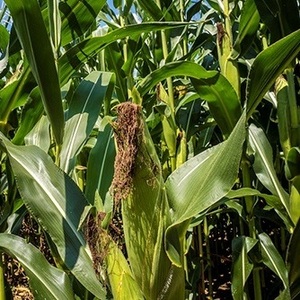USDA: Viral tag team stymied by new corn germplasm

SOURCE: Preston Keres, USDA
July 11, 2022
BY USDA Agricultural Research Service
A new corn germplasm resource developed by Agricultural Research Service scientists in Wooster, Ohio, is now available to use for breeding commercially grown varieties that can withstand the synergistic viral disease, maize lethal necrosis (MLN).
First reported in the late 1970s in Kansas and Nebraska, MLN today has become a global threat to corn (maize) production worldwide, particularly in East Africa, where initial outbreaks in Kenya inflicted yield losses of up to 90 percent. Maize lethal necrosis also is problematic in South America and Asia.
The disease strikes when corn plants are co-infected by the maize chlorotic mottle virus, which was first detected in Peru, and by maize-infecting potyviruses, which occur globally. Foliar symptoms progress from minor yellow mottling and mosaic-like symptoms to severe necrosis throughout the leaf. Other symptoms include stunted growth, premature aging, poor grain-fill of ears and drying of the entire plant followed by death.
Growers use a combination of methods to prevent or minimize MLN. These include controlling weeds like johnsongrass that can serve as reservoirs of the viruses as well as the insects that transmit them while feeding. Another tactic is rotating corn with non-host crops on which the culprit viruses cannot survive. However, planting disease-resistant varieties is the cornerstone defense, noted Erik Ohlson and Mark Jones, both with the ARS's Corn, Soybean and Wheat Quality Research Unit in Wooster.
Advertisement
Toward that end, the two ARS researchers developed the "synthetic" corn population OhMCMV-1 as a germplasm resource. Resistance to maize chlorotic mottle virus is rare and OhMCMV-1 offers breeders a new breeding resource with novel combinations of resistance genes that can be used.
"A synthetic population is a term used to describe a breeding population that was developed from several parental lines with a specific trait or breeding goal," Ohlson, a plant geneticist, explained. "In this case, five MLN-tolerant corn lines were cross-pollinated with each other in all combinations over multiple generations to recombine the genetic backgrounds from these five parents." The researchers selected the most maize chlorotic mottle-tolerant plants to recombine and advance to the next generation, a breeding strategy called recurrent selection.
Growth chamber tests show that OhMCMV-1 plants can withstand the viruses that cause MLN as well as or better than its five parental lines. Credit for that goes to new combinations of multiple unique resistance genes from the five parental corn lines used for population development.
OhMCMV-1 is not intended for commercial production directly, but rather as breeding material from which elite commercial varieties or hybrids can be developed, according to the researchers, who published the results of their evaluations of OhMCMV-1 in the Journal of Plant Registrations. The population is being released after one cycle of selection for tolerance to maize chlorotic mottle virus and a second cycle of selection is in progress, added Jones, an agronomist.
Advertisement
"The maize lethal necrosis epidemic in East Africa was a major consideration when this project was undertaken, but OhMCMV-1 has value for anywhere the maize chlorotic mottle virus occurs or maize lethal necrosis is or may become problematic," Ohlson said.
Current practices used by U.S. corn growers have kept the disease in check, coupled with the limited occurrence of maize chlorotic mottle virus. However, OhMCMV-1 can nonetheless be adapted to conditions in the U.S. Corn Belt, if necessary—thanks to a temperate-adapted parent among the five that were used.
Small quantities are available to qualified professional plant breeders and other research scientists upon request.
Related Stories
The USDA on April 14 announced the cancellation of its Partnerships for Climate-Smart Commodities program. Select projects that meet certain requirements may continue under a new Advancing Markets for Producers initiative.
The USDA reduced its outlook for 2024-’25 soybean oil use in biofuel production in its latest World Agricultural Supply and Demand Estimates report, released April 10. The outlook for soybean oil pricing was revised up.
BDI-BioEnergy International has signed a contract with Ghent Renewables BV to begin the construction of a pioneering biofuel feedstock refinery plant. Construction is underway and the facility is expected to be operational by the end of 2025.
Gevo subsidiary announces agreement with Minnesota Soybean Processors to track and verify sustainable agriculture attributes
Verity Holdings LLC, a subsidiary of Gevo Inc., has partnered with Minnesota Soybean Processors (MnSP) to implement Verity’s proprietary track and trace software. The collaboration aims to unlock additional value through export premiums.
U.S. operatable biofuels capacity increased slightly in January, with gains for ethanol, according to the U.S. EIA’s Monthly Biofuels Capacity and Feedstock Update, released March 31. Feedstock consumption was down when compared to December.
Upcoming Events










